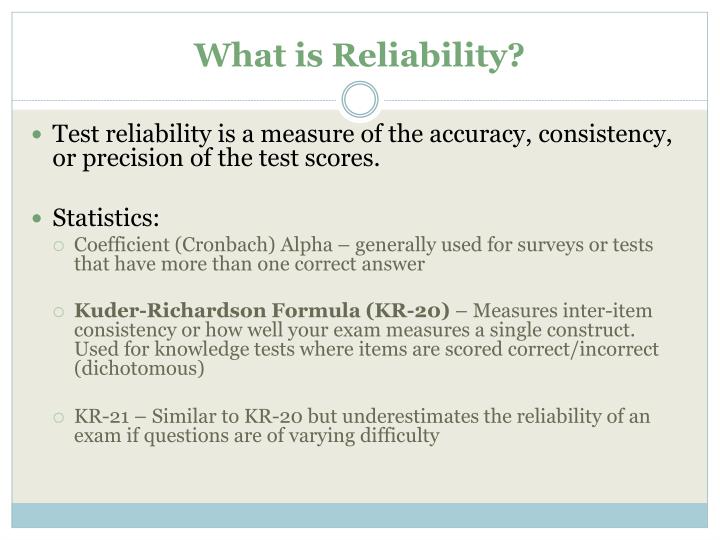

Platinum objects of fixed weight (one kilogram, one pound, etc.) are kept locked away. Results are compared and correlated with the initial test to give a measure of stability.Īn example of stability reliability would be the method of maintaining weights used by the U.S. To determine stability, a measure or test is repeated on the same subjects at a future date. Stability reliability (sometimes called test, re-test reliability) is the agreement of measuring instruments over time. In other words, studying was not a reliable predictor of shopping for gifts. The researcher concluded there was poor equivalency reliability between the two actions.

The researcher used the results of the observations to assess the correlation between studying throughout the academic year and shopping for gifts. Intrigued by this, the researcher attempted to observe how often, or to what degree, this these two behaviors co-occurred throughout the academic year. An important consideration is that equivalency reliability is concerned with correlational, not causal, relationships.įor example, a researcher studying university English students happened to notice that when some students were studying for finals, their holiday shopping began.

In quantitative studies and particularly in experimental studies, a correlation coefficient, statistically referred to as r, is used to show the strength of the correlation between a dependent variable (the subject under study), and one or more independent variables, which are manipulated to determine effects on the dependent variable. Equivalency reliability is determined by relating two sets of test scores to one another to highlight the degree of relationship or association. For researchers, four key types of reliability are: Equivalency ReliabilityĮquivalency reliability is the extent to which two items measure identical concepts at an identical level of difficulty. Reliability is such an important concept that it has been defined in terms of its application to a wide range of activities. In addition to its important role in research, reliability is critical for many parts of our lives, including manufacturing, medicine, and sports. Without the agreement of independent observers able to replicate research procedures, or the ability to use research tools and procedures that yield consistent measurements, researchers would be unable to satisfactorily draw conclusions, formulate theories, or make claims about the generalizability of their research. Reliability is the extent to which an experiment, test, or any measuring procedure yields the same result on repeated trials. These related research issues ask us to consider whether we are studying what we think we are studying and whether the measures we use are consistent.


 0 kommentar(er)
0 kommentar(er)
